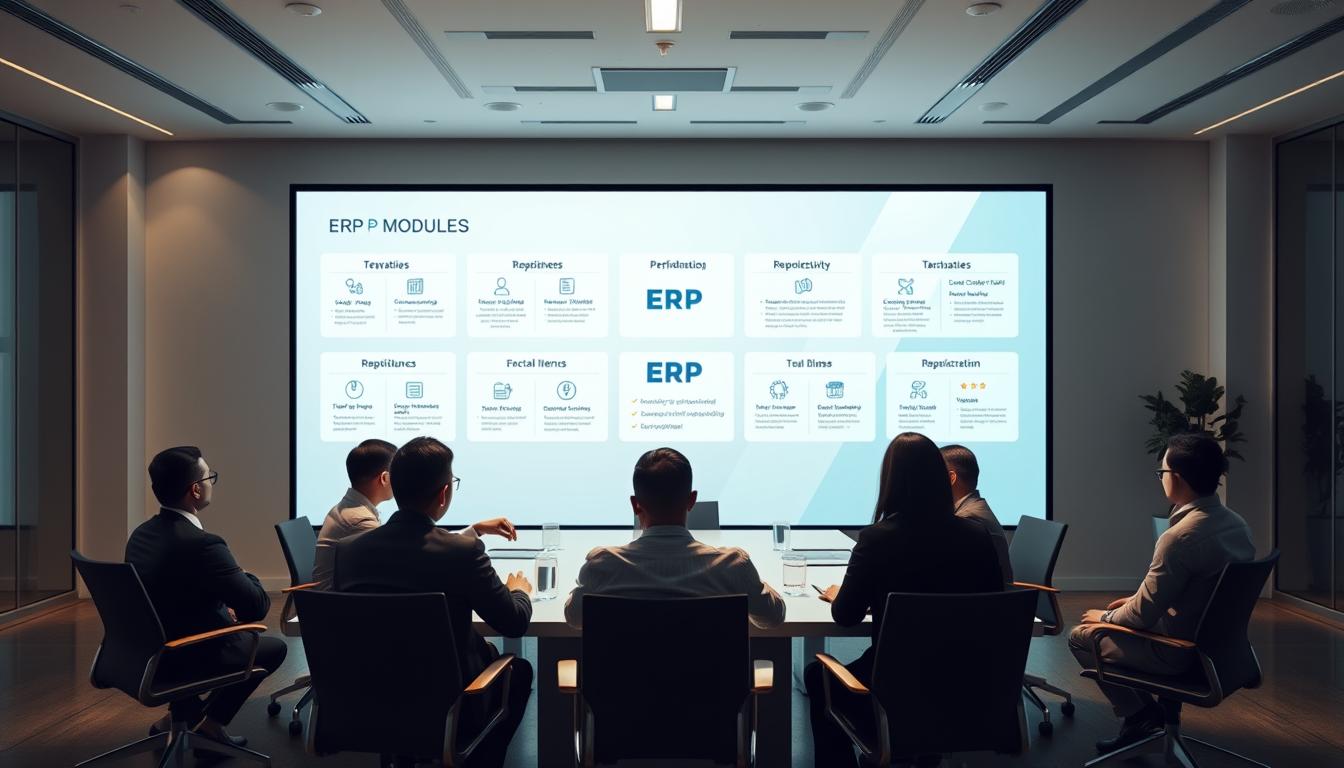Is your ERP system keeping up with your business’s fast growth? Or is it holding you back? For small and medium-sized enterprises (SMEs) in the Philippines, adding new ERP modules is key. This lets your system grow with your business, keeping things efficient and streamlined.
This article will show you how to add new modules that fit your changing needs. It’s all about making your ERP system work better for you.
Key Takeaways
- ERP systems must be scalable to adapt to business growth.
- Identifying unique business needs is crucial before integrating new modules.
- Assessing current ERP capabilities can highlight areas for improvement.
- Researching relevant ERP modules tailored to your industry supports effective upgrades.
- Training staff becomes essential for smooth implementation of new modules.
- Continuous performance monitoring post-integration ensures ongoing effectiveness.
Understanding the Importance of ERP System Scalability
ERP system scalability is key for any business to grow. As companies get bigger, their needs change. They need systems that can grow with them. A scalable ERP system lets you add new features easily without changing everything.
This makes sure businesses can keep up with their business growth plans.
Odoo shows how important flexibility is. It lets companies add different features as they need them. This is great for businesses in fast-changing markets like the Philippines.
By choosing scalable ERP solutions, companies can quickly adapt to new market demands. This way, they’re ready for today and tomorrow.
Identifying Business Needs for Scalability
Understanding specific business needs is key to determining scalability of an ERP system. A detailed approach to assessing business needs is crucial. The first step is a gap analysis in ERP to look at current operations.
This analysis finds inefficiencies and spots gaps that could block growth. It’s important to talk with department heads from sales, finance, and inventory management. These talks help clarify what’s needed for growth.
Each department has its own needs. Knowing these helps make smart choices about new ERP modules. This ensures the system supports the company’s strategy.
Getting a clear picture of these needs opens up better scalability options. This helps the company grow as the market changes. By focusing on key elements, companies can handle the challenges of scaling their ERP systems.
Assessing Current ERP Capabilities
Before adding new modules to an existing ERP system, it’s important to assess its current capabilities. This starts with a detailed system evaluation. It looks at what the system can do now and how well it works.
Businesses need to see how the system fits into their daily operations. They should also check if it can grow with their business. This ensures the system can handle future needs without problems.
A functional analysis helps identify what the system does well and what it doesn’t. Knowing these areas is key to smoothly adding new modules. It’s important to see if the system can keep up with new changes.
Having a strong ERP system boosts efficiency. This is crucial for small and medium businesses in the Philippines. They aim to make their processes better and more efficient with new modules.
Researching ERP Modules for Your Industry
Choosing the right ERP modules is key for small and medium enterprises (SMEs). Each industry has its own needs, shaping the ERP choice. SMEs in retail, manufacturing, and services must find modules that fit their goals.
Doing deep market research helps SMEs find the right solutions. Platforms like Odoo offer various modules for better customer management, inventory, and project tracking. This focus on sector-specific needs leads to better decisions.
Keeping an eye on industry trends is also important. Seeing what others use helps spot good practices for your business. This approach supports both current needs and future growth.
To learn more about CRM systems and field sales, check out this resource. Insights from such sources can help when picking ERP modules.
| Industry | Key ERP Modules | Specific Requirements |
|---|---|---|
| Retail | Inventory Management, POS Systems | Real-time inventory tracking, sales analytics |
| Manufacturing | Production Planning, Supply Chain Management | Resource optimization, quality control |
| Service | Project Management, CRM | Client interaction, performance measurement |
Plan Integration of New Modules
Effective ERP module integration starts with a solid implementation roadmap. This roadmap is a detailed guide, showing each step of the integration. First, assess your current workflows to see how new modules will change them. This is key for good strategic planning.
Then, plan out key areas like data migration, user training, and keeping operations running. A clear timeline helps you see how the integration will unfold. It lets you make changes as needed. Breaking the process into smaller steps helps users adjust slowly, keeping productivity high during the change.
Here’s a sample table showing the main steps in the integration process:
| Step | Description | Timeframe |
|---|---|---|
| Assessment | Evaluate existing workflows and determine integration needs. | 1-2 Weeks |
| Planning | Create a detailed implementation roadmap with timelines. | 1 Week |
| Data Migration | Transfer relevant data from previous systems to the new module. | 2-4 Weeks |
| User Training | Conduct training sessions to familiarize users with new features. | 1-3 Weeks |
| Go Live | Implement the integration and monitor the system. | 1 Week |
By following this structured plan, your business can smoothly integrate new ERP modules. It also keeps your business focused on growth and improvement.
Evaluating Compatibility of New Modules
When expanding an ERP system, the ERP compatibility assessment is key. Companies must check how new modules fit with the current setup. They look at software versions and how well modules talk to each other.
Starting to solve system integration challenges early can save time and money. If a new module needs big changes, it might cause delays and extra costs. It’s also crucial to see if the current hardware can handle more modules to prevent slowdowns.
Businesses should follow certain module selection criteria when choosing new modules. These include matching with current software, easy communication between modules, and meeting company goals. By carefully considering these, companies can make their ERP system more efficient and growable.
Testing New ERP Modules Thoroughly
Testing new ERP modules well is key before they’re fully used. Doing unit and system-wide tests checks each module’s work. It also makes sure data is correct everywhere in the system. This careful testing helps avoid problems when modules are put together.
Getting users to test the modules helps a lot. Their feedback makes the system better and easier to use. This teamwork makes the new modules stronger and more reliable. It also makes users happier and more confident.
Implementing User Training for New Modules
Adding new ERP modules works best with good user training. User training strategies help teams with different skills levels. This makes sure everyone knows how to use the new system well.
A good employee onboarding process uses these strategies. It helps staff get the most out of new features.
Teaching some employees to be experts in new modules is smart. This method helps everyone learn from each other. Workshops, seminars, and online courses are key for learning ERP.
It’s important to keep training going with refresher sessions. These sessions help solidify what’s learned and clear up any doubts. By focusing on training, companies can quickly get used to new tech. This makes work smoother and more productive.
For more on training, check out effective HR training and development. It offers tips for the Philippines.
| User Training Methods | Advantages | Considerations |
|---|---|---|
| Workshops | Interactive learning, immediate feedback | Requires scheduling and space |
| Online Courses | Flexible pacing, accessible resources | Self-motivation needed |
| Coaching Sessions | Personalized guidance, targeted skill development | Time-intensive, limited reach |
| Refresher Courses | Reinforces learning, updates users on new features | Must be scheduled regularly |
Using these user training strategies helps employees use updated systems well. This boosts efficiency and success in reaching business goals.
Monitoring Performance Post-Integration
It’s vital to watch system performance closely after adding new ERP modules. This helps businesses see how these changes affect their work. They look at things like how stable the system is and how well users like it.
Looking at performance metrics shows where things can get better. This helps the ERP system grow with the company. By keeping an eye on performance, businesses can make their systems better and work more efficiently.
| Performance Metrics | Importance | Action Steps |
|---|---|---|
| User Adoption Rate | Shows how well users are getting used to new modules | Provide additional training resources if needed |
| System Stability | Checks if the system is reliable after integration | Address technical issues quickly to maintain operations |
| Process Efficiency | Looks at how new modules improve workflows | Adjust processes based on feedback and performance data |
These insights help make important changes to the ERP system. This ensures it stays useful and meets the company’s goals.
Scalability & Upgrades in ERP Systems
Understanding how ERP upgrades and scalability work together is key for growing businesses. As companies grow, they need to keep their systems up to date. Regular checks on ERP systems can show where improvements are needed.
Scalability is important for handling more work. Companies with scalable ERP systems can easily adjust to changes. Upgrades keep systems running smoothly, even with more data and transactions.
Checking ERP systems often helps find needed upgrades. This keeps businesses flexible. Staying current with industry trends helps SMEs meet new needs.
| ERP System Feature | Before Upgrade | After Upgrade |
|---|---|---|
| Data Processing Speed | Moderate | High |
| User Capacity | 50 Users | 200 Users |
| Integration Flexibility | Limited | Extensive |
| Customization Options | Basic | Advanced |
| Analytics & Reporting | Standard | Advanced |
Investing in ERP upgrades and scalability is crucial for growth. As businesses change, they need better systems. This leads to better work flow and easier growth.
Learning from Case Studies in the Philippines
ERP case studies from Filipino SMEs offer valuable lessons. They show how companies have made their ERP systems work better. This has led to more efficiency and new ways of doing things.
These stories highlight common practices that help SMEs succeed. Key factors include:
- Clear objectives: Having clear goals helps everyone know what to aim for.
- Stakeholder involvement: Getting everyone involved makes it more likely to succeed.
- Iterative approach: Making small changes helps avoid overwhelming the system.
By learning from these stories, Filipino SMEs can use ERP systems better. They can face challenges and find new chances for growth in today’s market.
| Company Name | Industry | Implemented Modules | Key Outcome |
|---|---|---|---|
| ABC Manufacturing | Manufacturing | Inventory Management, Quality Control | Reduced waste by 30% |
| XYZ Retail | Retail | Sales Tracking, CRM | Improved customer retention by 25% |
| DEF Services | Service | Project Management, Time Tracking | Increased project deliveries on time by 40% |
Additional Considerations for Successful ERP Module Integration
Adding new modules to an ERP system needs careful thought. It’s important to know your current business processes. Also, find out where new modules can help fill gaps.
Integrating new modules can bring challenges. Employees might resist change, or there could be technical issues. To solve these, teams should be open to change and quick to adapt.
Joining ERP communities can help. They share the latest trends and ERP best practices. Staying up-to-date with technology and methods is key to a smooth integration.
By tackling these issues head-on, businesses can make ERP integration a success. Being informed and flexible helps ERP systems grow with the company’s needs.
Conclusion
ERP integration is key to a company’s success. It needs a strategic plan that changes with business needs. This approach helps improve operations and prepares for growth.
Businesses in the Philippines face many challenges and chances. Using ERP systems well is crucial for lasting success. It helps them grow and stay ahead.
Companies should keep adding new modules to meet their needs. This makes their systems better and more innovative. It helps them stay competitive in a fast-changing market.
Using ERP systems fully can make processes smoother and open up new growth chances. With good planning, any business can achieve ERP integration success. This is true for any company aiming to thrive in the Philippine market.




